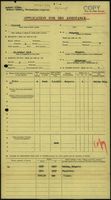Variation
Page of
- Reference


The CM/1 applications that were filled out in Italy are stored together in their own collection in the Arolsen Archives. At first glance, these forms look different from the CM/1 applications that were used outside of Italy. But the only difference is that the pages were not cut, so the form is one long sheet of paper printed on both sides. It is notable that photographs of the applicants are attached to many of these forms.
There were more than 30 DP camps in Italy, and researchers estimate that there were around 50,000 Jewish DPs alone. An organization known as Brichah was one reason that thousands of Eastern European Jews in particular found themselves in Italy after the war. Until the founding of the State of Israel in 1948, this Jewish organization arranged for Jews to emigrate illegally to Palestine via Italy. The British mandatory power used quotas and prohibitions to regulate emigration to Palestine for a long time, so many survivors tried to cross the border illegally to get around this regulation.
The CM/1 applications that were filled out in Italy are stored together in their own collection in the Arolsen Archives. At first glance, these forms look different from the CM/1 applications that were used outside of Italy. But the only difference is that the pages were not cut, so the form is one long sheet of paper printed on both sides. It is notable that photographs of the applicants are attached to many of these forms.
There were more than 30 DP camps in Italy, and researchers estimate that there were around 50,000 Jewish DPs alone. An organization known as Brichah was one reason that thousands of Eastern European Jews in particular found themselves in Italy after the war. Until the founding of the State of Israel in 1948, this Jewish organization arranged for Jews to emigrate illegally to Palestine via Italy. The British mandatory power used quotas and prohibitions to regulate emigration to Palestine for a long time, so many survivors tried to cross the border illegally to get around this regulation.

Questions and answers
- What are considered variations in the e-Guide?
The e-Guide distinguishes between main cards and variations. The reason for this is that there are sometimes different versions of a single type of document that can vary significantly.
The documents referred to as main cards in the e-Guide are standard documents that were used especially frequently in concentration camps, DP camps, and for the registration of forced laborers, and about which a good deal of information is available. The Arolsen Archives also hold variations of these documents, however, which served the exact same purpose as the corresponding main cards, but which look different. There are various reasons for this: Some camps used their own individually produced cards instead of the standard versions. In many other cases, individual cards and forms were used before the introduction of standardized pre-printed forms.
- Do you know more about the document?
If you have any additional information about this document or any other documents described in the e-Guide, we would appreciate it very much if you could send your feedback to eguide@arolsen-archives.org. The document descriptions are updated regularly – and the best way for us to do this is by incorporating the knowledge you share with us.